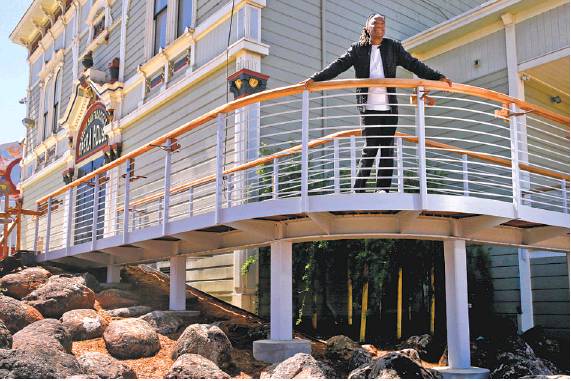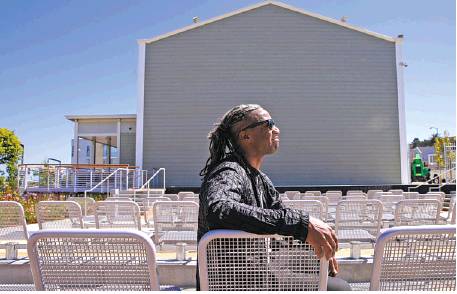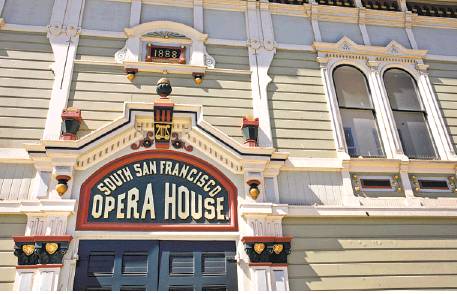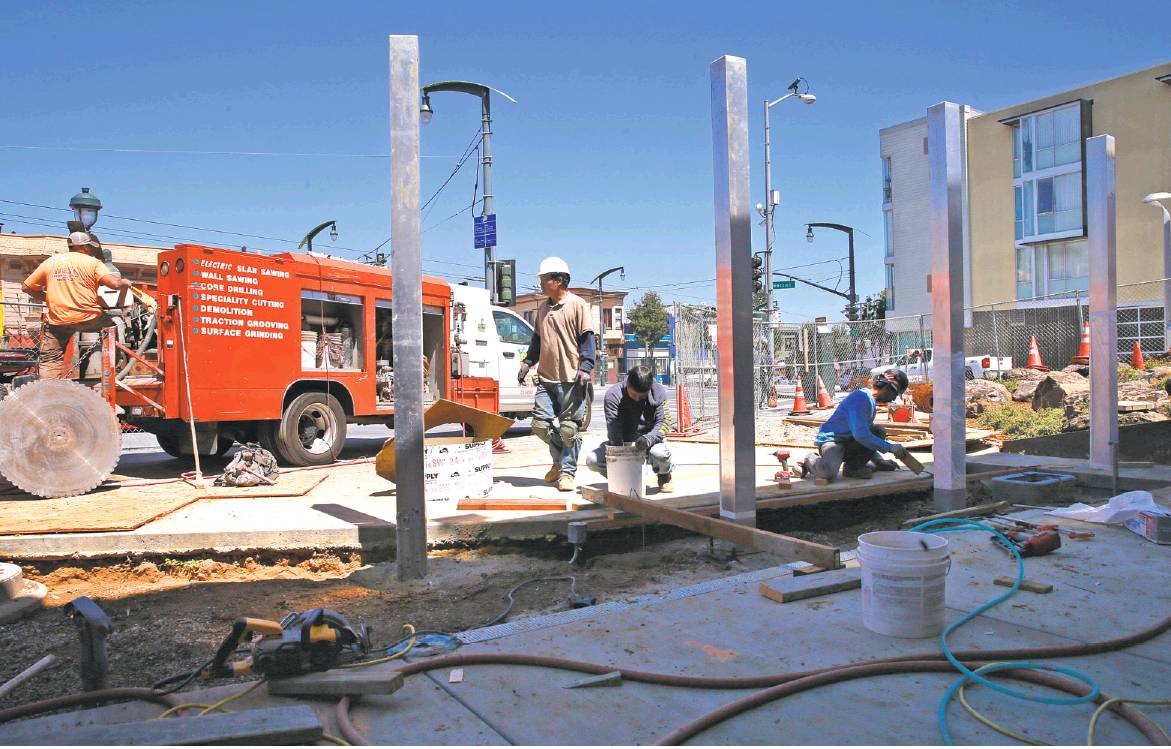Opera House stages revival in Bayview
By Sam Whiting
When the time finally came to renovate the landmark Bayview Opera House, designer Walter Hood decided to elicit neighborhood feedback the way it would have been done in 1888 when the hillside auditorium was built.
He dragged a rocking chair onto the porch overlooking Third Street and invited neighbors to tell him what they thought of the old barn, which wasn’t much. Those who could find it, hidden behind a brick wall and thicket of trees, lined up to speak to the esteemed Hood, one-on-one. There was a 30-minute maximum, and some needed it all.
“People spoke passionately about how this place had been taken away from them over the years. They wanted it to be theirs again,” recalls Hood, a professor of landscape architecture at UC Berkeley. “This place was a closed bunker, and they wanted it to be open.”
Three years and $5.7 million later, most of that brick wall is gone and so are the trees. From the T-Third Street line you can plainly see the BVOH, for 128 years the art and culture hub of this struggling neighborhood.
The historic building itself, refurbished and brought up to code by the San Francisco architecture firm TEF Design, won’t open until September. But now nobody wants to wait that long to see it up close. A preview ribbon cutting and community open house will be held Wednesday evening.
“The facility is changed from the ground up,” says Barbara Ockel, executive director of Bayview Opera House Inc. “It used to look so uninviting and ugly that nobody would want to come in.”
Ockel’s organization is a nonprofit that pays rent in the amount of $1 a year to the San Francisco Arts Commission, which also owns the South of Market Cultural Center, the Mission Cultural Center for Latino Arts, and the African American Art & Culture Complex in the Western Addition.
More than a building
Among these, BVOH is the smallest, “but it’s a place that holds a lot of history for an African American community that has experienced stress and dislocation,” says Judy Nemzoff, director of community investments for the arts commission. “The passion in doing a beautiful renovation is to send a message that we recognize how important this building is and will continue to be.”
BVOH is now way more than a building. It looks like a park more than anything else. Two-thirds of the triangular lot is an outdoor plaza with a rock garden and a stage above comfy bucket seats for 60. The parking lot has been reduced by half to make way for a lawn and butterfly garden.
The other third of the lot is the wooden auditorium with letters carved into the facade proclaiming this to be the South San Francisco Opera House, even though it is not in South San Francisco, and “no opera was ever performed there,” says Nemzoff.
But it was built before South San Francisco existed as a city, and its name advertised its position as the southernmost live entertainment venue in the city, offering comedies, minstrel shows and vaudeville.
The Opera House part of the name is easier to figure because that was a common description for a style of open-hall architecture in the 19th century when it was built as Masonic Lodge No. 212.
The wooden structure, 50 feet wide and 100 feet long, was built on top of a solid rock that can be seen through a door under the stage. Those Masons were onto something. When everything else shook loose in major earthquakes, the BVOH stood on its rock and survived to become the oldest theater in the city.
The Masons used it until the 1930s, and then it bounced along in any number of uses, including a pool hall, until it was sold to a private owner in 1965. The place had fallen into disrepair and probably would have been torn down if it had not been named city landmark No. 8, in 1968. The adjacent Masonic Temple was not a landmark, and it was demolished in 1975, replaced by an open-air entrance porch.
The name first became misleading when South San Francisco was incorporated as its own city, in 1908. Sometime in the 1970s, it became known more accurately as the Bay-view Community Center, but the Opera House handle was stubborn and it became the Bayview Opera House.
In 1989, Bayview Opera House Inc. was founded to run the programs, and in 1995 the name was amended to Bay-view Opera House Ruth Williams Memorial Theater, after an African American actress and producer who taught classes and put on plays there. That name is set in tile on part of the brick wall that was saved for that purpose.
Historic designation
In 2011, it was added to the National Register of Historic Places, to honor its architect Henry Geilfuss and the blend of Italianate, Gothic, Eastlake and Stick styles that melded into a Victorian mutt.
The landmark designation came just after it was revealed that the tall wood and plaster wall behind the stage was rotten and was leaking water into the dressing rooms.
The outdoor stage had to be removed and the wall rebuilt down to the foundation, at a cost of $500,000. This began a long-simmering plan to overhaul the entire property.
When Hood first saw the grounds, it was “very brutal,” he says, speaking architecturally. “A lot of brick and a lot of level changes, with wooden benches donated from Ghirardelli Square in the 1970s.”
Steps had been added to the exterior, and to get from one side to the other you had to go downstairs then upstairs. The stage for the outdoor theater was concrete. So was the garden.
In the renovation, all of these add-ons have been subtracted, and all the concrete replaced by reclaimed redwood. Most of the brick wall has been replaced by a fence of steel tubing. Look between the tubes on the Third Street side, and you’ll see a dump-truckload of mossy boulders in the garden.
You can study the rocks from above, on the elevated boardwalk, and you can also study the Bayview neighborhood, from the white steeple of All Hallows Church eastward to Potrero Hill. This promontory is open and free to anyone, and minus all those stairs the entire property is ADA compliant.
“The idea is that when the community comes back it’s a different place with a different view,” says Hood.
But the auditorium still looks the same, like an Odd-fellows or Native Sons of the Golden West meeting hall in any small town. What makes the BVOH stand out is the T-Third Street rumbling along below it.
Get off at the Oakdale stop, and you are in the urban core of the 21st century. Go around the corner, and you are in the 19th. The sign above the door reading South San Francisco Opera House is still there, in gold paint to match the trim work.
Inside, the proscenium around the stage has been preserved as has the original floor of Douglas fir, with a capacity of 300. The balcony has been saved, but since there is no way up there that meets current code, it is permanently closed.
No bond money used
The renovation was done without bond money, and the $5.7 million was cobbled together from a variety of city funds. The largest contribution, just under $1 million, came from the Mayor’s Office on Disability as pushed forth by its director Carla Johnson, whose email signature carried her words “disability rights are civil rights. Separate but equal is not equal.”
Johnson died June 12, at age 57, unable to see her project through. In her memory, Bay-view Opera House Inc. is raising funds for a signature public artwork to stand at the corner of Third Street and Newcomb Avenue. Funds are also being raised for the theater infrastructure, which was not covered in the construction.
“We need a new sound system and a new lighting system and projection equipment,” says Ockel. “The Bayview Opera House is fundraising for these items.”
On Sept. 17, BVOH Inc. will hold its own public grand opening on the outdoor stage, featuring PUSH performing “Point Shipyard,” a site-specific abstract dance. There will also be a performance of two songs written specifically about BVOH by HipHopfor-Change Inc. Feline Finesse Dance Company, composed of kids from the Bayview, will also perform.
On Sept. 18, BVOH Inc. will move back into the building to go about the business it has been conducting here since 1989. This includes an after-school arts education program called “Dare 2 Dream,” in which 300 kids dabble in dance, painting, theater, ceramics, yoga, gardening and cooking.
For the last full year it was open, fiscal 2012-13, 35,000 people either attended classes or participated in events at BVOH. “That was before you could see it, ” says Ockel, who expects the visibility to increase usage to 50,000 people in fiscal 2016-17, and 70,000 the year after that.
There will be line dancing Monday nights and music performances on the outdoor stage on Saturday afternoons through the fall. The first indoor performance before a paid audience will be the Sphinx Symphony, an all-star black and Latino orchestra, on Oct. 2.
“Still no opera,” says Ockel, “but I’m sure it will be coming.”
Sam Whiting is a San Francisco Chronicle staff writer. Email: swhiting@sfchronicle.com Twitter: @SamWhitingSF



